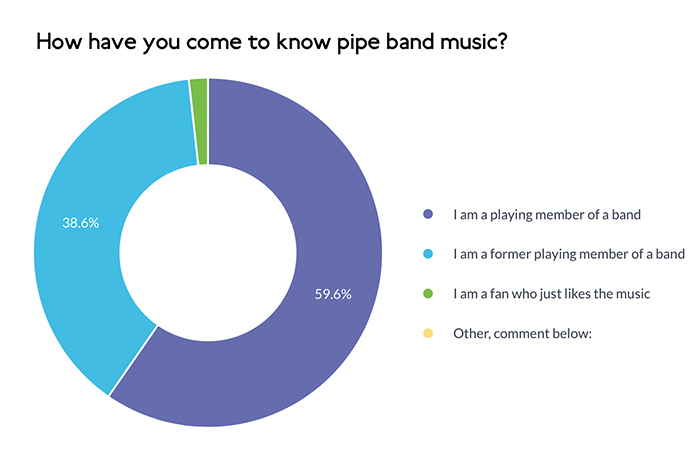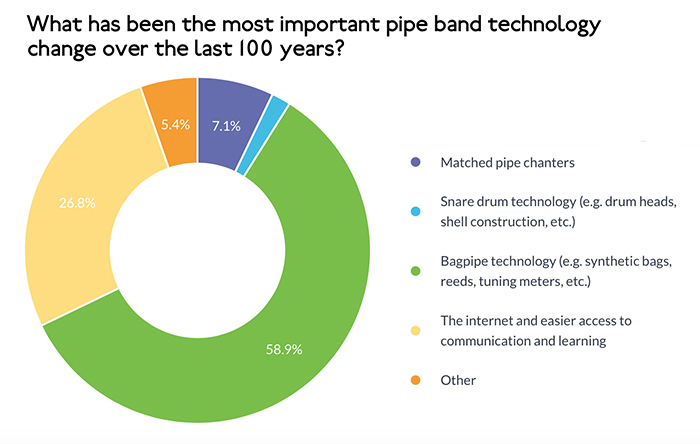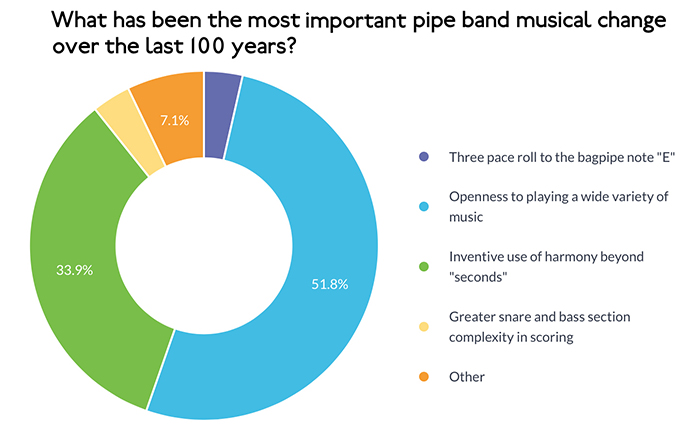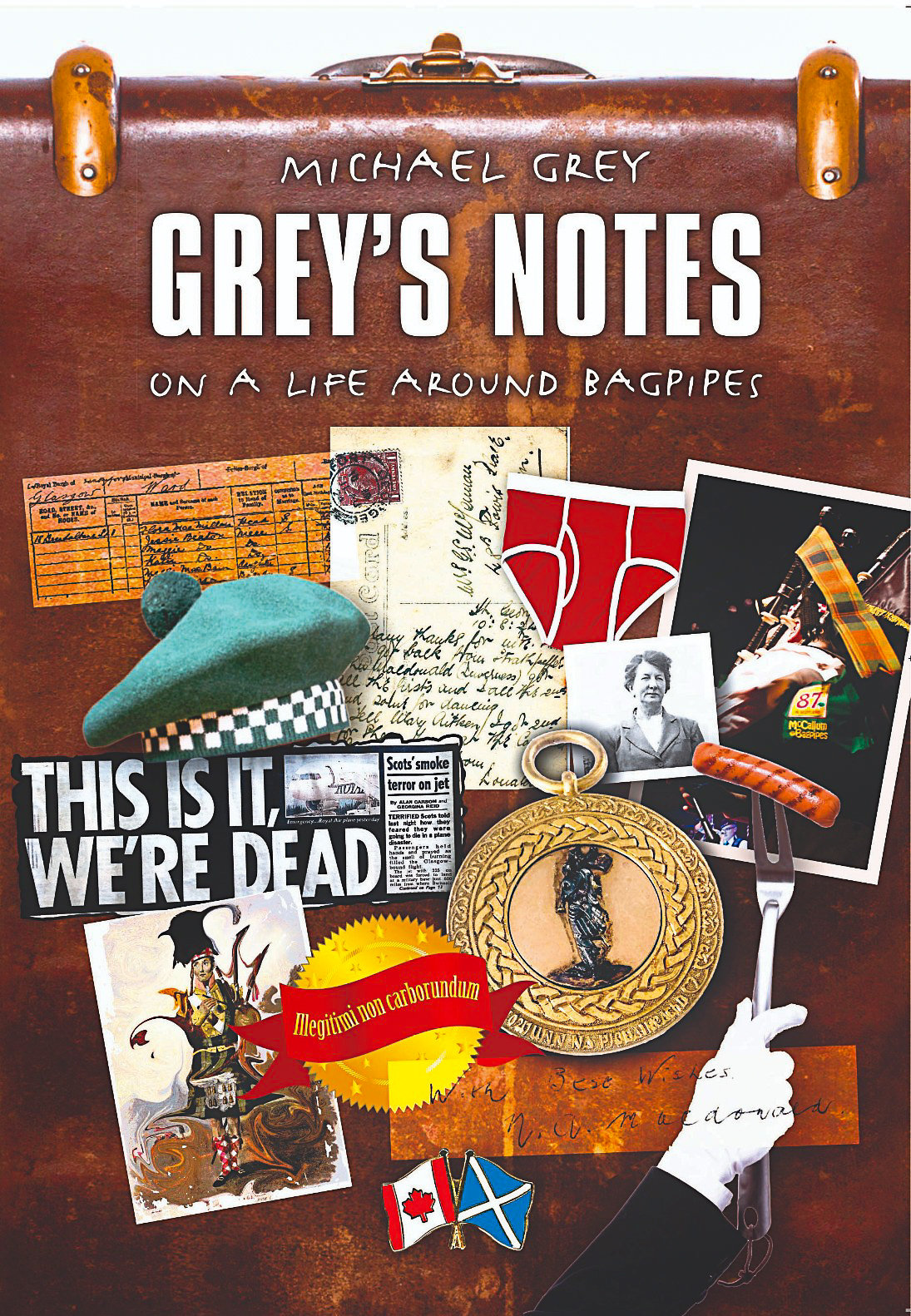Survey Summary: 100 Years of Pipe Bands
January 1, 2020 on 8:00 am by Michael Grey | In News, Pipe Bands | Comments Off on Survey Summary: 100 Years of Pipe BandsWith over 200 respondents a summarized view can now be passed along of the “100 years of pipe bands” survey offered last month to readers of bagpipe.news (and those of my blog). In my working life (corporate communications) I’ve always found surveys a good way to take a temperature check of a group of people. You’ll know political pollsters are masters in calculating the exactness – or degree of accuracy – of any group of responses. You may be surprised to find – as I once was – that response levels do not have to be especially high to show a degree of accuracy. I projected that 5000 people would likely be reached through both bagpipe.news and blog channels. Considering participant rate and target audience size it might be said that from the “100 years of pipe bands” survey, a confidence level of 95% can be inferred, with a margin of error of 7%. Margin of error (that the results don’t jive with the perspective of the target group) is quite high here. 5% is the industry standard (you can read more about confidence levels and survey margins of error here).
One other note on the survey outcome. I reflect: many of the participants would be readers of my blog and so be inclined (I imagine) to have a bias for some of the music that has been my life. I believe that should be acknowledged in digesting survey outcome. And, everything aside, my aspiration was to have a sense of what people thought about 100 years of pipe bands. I sought a simple test, like a finger to the wind. And that’s surely what we have.
Question 1:

Question 2:
Thinking of military pipe bands, what is your favourite “tune of Glory”? (i.e. “Highland Laddie”, “All the Blue Bonnets”, “Brown-haired Maiden, etc.). Feel free to add more than one title!
Responses were remarkably diverse with five tunes rising to the top. “The Black Bear” was a resounding winner.
1. The Black Bear
2. All the Blue Bonnets are Over the Border
3. Highland Laddie
4. Scotland the Brave
5. The Green Hills of Tyrol
One thoughtful participant wrote: “I think “A Man’s a Man”, archetypical of the standard practice of repurposing songs as marches, melodic source material serving a new function. I also appreciate its regimental use as a tune played for disciplinary measures, sending a subtle reminder not to vilify (or lionize) your fellow man. We all screw up pretty badly.”
No one else picked “A Man’s a Man”. Not that you asked and as an aside, my favourite version of the thoughtful person’s offering is by Paolo Nutini.
Question 3:
What is your favourite piece of music that has been played by a pipe band?
This category had a surprising outcome. The composer doesn’t play the pipes. There were multiple mentions of many fine pieces of music: said one, “How to choose?! I think it’s Lochanside”.

One piece did burble to the top: Don Thompson’s, “Journey to Skye”. A piece that first debuted in August 1987 in Ballymena, Northern Ireland. Don is a big star in the jazz world and, may’ve been influenced by his late wife, Norma (Nicholson). Norma was a great piper from British Columbia. I contacted Don when the survey showed his “J2S” to be a pipe band favourite. He said:
“It still amazes me that my piece has been acclaimed this way. I do think it’s a good piece though and I’m happy and honoured that people in the piping world are enjoying it. When I finished the score I remember giving it to Norma. She got out her pipes, put the score on a music stand and just read it off straight through, barely stopping between the sections and gave it back to me saying something like “it’ll be ok”. She did a lot of studio work and was a great sight reader. A couple of times I remember her getting called by the composer of a major film production for advice on how to write for pipes. I usually wound up explaining to the composer how the pipes worked and what was or was not possible. I learned quite a bit about the pipes from Norma but I never attempted to play them. I just knew that it would be way beyond anything I’d ever be able to do.”
Bill Livingstone was the P/M of the 78th when the band played this piece. I asked him for his comment:
“The scene is Fergus highland games 1987. We had the music for a year and had finally made sense of it. The band gathered in the big trees on the the hillside of that lovely games ground, and after a blow to settle the pipes, we launched into Journey to Skye – the complete piece from opening solo to the end. We knew we were to play it at Ballymena a few days later and it had never had a real test before an audience. As we progressed through the piece, people, pipers, fans, music-lovers began to materialise through the trees and surround us. We were used to attracting a crowd during tune up but this was of a different order. They stood silent, listening with great attention. When we stopped, they mostly stood gobsmacked. We knew we had something special.”
Question 4:
What pipe band recordings are among your favourite? (reference vinyl, CDs, online or streaming sources as you like)
Responses were remarkably diverse, almost like a catalogue of recordings of bands over the last 70 years. One recording did emerge as a favourite (reminder: note my intro context to this survey): “Live in Ireland” by the 78th Fraser Highlanders (1987). An alphabetical list here of the many recordings that were mentioned in the same number of multiple times:
“Ascension” – Inveraray & District (2013)
“Ceolry” – Greater Glasgow Police (2014)
“Dawning of the Day (The)” – Saint Laurence O’Toole (2005)
“Debut” – Field Marshal Montgomery (1991)
“Forte” – Boghall & Bathgate Caledonia (2013)
“Impact” – Field Marshal Montgomery (2017)
“Live at Carnegie Hall” – Simon Fraser University (2007)
“Live ’n Well, The Motherwell Concert” – Vale of Atholl (1996)
“Masterblasters” – Victoria Police (1998)
“Six in a Row” – Strathclyde Police (1988)
Question 7:
Across the whole repertoire that has been performed by pipe bands, what is your favourite “tune” or “piece” of music?
In retrospect this question might have been put a different way, even had it offered up a selection of arbitrary tunes with a “write-in” option. What came back were scores of different tunes and pieces, or suites – and that’s on me for giving you a poor “question 7”. One tune did emerge, George S McLennan’s “The Little Cascade” with “too hard to say” a close second. J2S figured, again; I guess to be expected.
This comment has to be shared, if only to have us all read (or learn, as was the case with me) the word, mondegreen:
“I love Cabar Feidh. I like the inversion of the more-common mixolydian double-tonic structure, with it starting in G and moving up to A. The way a melodic shape is moved up and down the register in parts two and three is minimalistic and effective. Alasdair Gillies highlighted its metric mutability by bringing together arrangements in five different idioms of his regimental march. The misunderstood Gaelic term ends up as a mondegreen in the Irish tradition as Copperplate (Old or New).”
Question 8:
Of those you have heard, live or recorded, what is your favourite competition “medley” or “selection”? (reference the intro tune and band if possible)?
Again, on reflection, this question may’ve been constructed better to be more informative, at least to help narrow down a list, had, say, a dozen medleys been listed followed by an ask to order by most-preferred. No one medley emerged as an overwhelming favourite, though these five appeared as the most-noted. They are listed here in alphabetical order of the medley’s opening tune:
Duncan Johnstone [the “For Ireland I Will Not Tell Her Name” medley] Simon Fraser University (2006)
Father John MacMillan of Barra – Inveraray & District (2019)
Mason’s Apron (The) – 78th Fraser Highlanders (1981)
Trevor Buckley [“The Fiddler’s Rally medley”] – Field Marshal Montgomery (2016)
Up to the Line – 78th Fraser Highlanders (1987)
Question 9:
Do you have any other comment related to pipe band music and the degree to which it has changed over the last 100 years?
Comment that was provided followed – with no notable exception – fell into three themes:
The “safeness” of today’s competition music
“I think we are not adventurous enough. Some medleys of 10+ years ago were more interesting than most of today’s – where most sound the same.”
“ … the format of medleys has remained largely unchanged since the late 90’s and early 2000’s. The result of this stagnation of the development of form has resulted in pipe band medleys becoming nearly as predictable and, some have argued, ‘samey’ as MSRs, even though they contain new music. …”
The internet and how it has connected us all for the better
“Ability to connect with band community over great distances. Skype is a great tool”
“With the new teck and things like social media and live streaming the piping world is no longer an exclusive club. It’s so much more international and inclusive.”
The positive impact of formal piping education
“Much of the improvements we see in piping is due to the integration of piping in more formal education settings. Ie. Public and private schools, summer schools and more knowledgeable teachers. …”
“I think a major development in pipe band music has been the apparent cross talk between our musicians and other corners of the trad world. Programs like RCS [The Royal Conservatoire of Scotland] have helped facilitate this further, and more pipe bandsmen than ever are big performers of the trad music. The bleed over has benefited pipe bands immeasurably.”
Thanks
To all who participated in the survey: thank you. Your contribution has given me something to think about and, with a little luck, will go a long way to inform another project. Stay tuned.
M.
No Comments yet
Sorry, the comment form is closed at this time.
Dunaber is using WordPress customized and designed by Yoann Le Goff from A Eneb Productions.
 Entries and comments
feeds.
Valid XHTML and CSS.
Entries and comments
feeds.
Valid XHTML and CSS.




